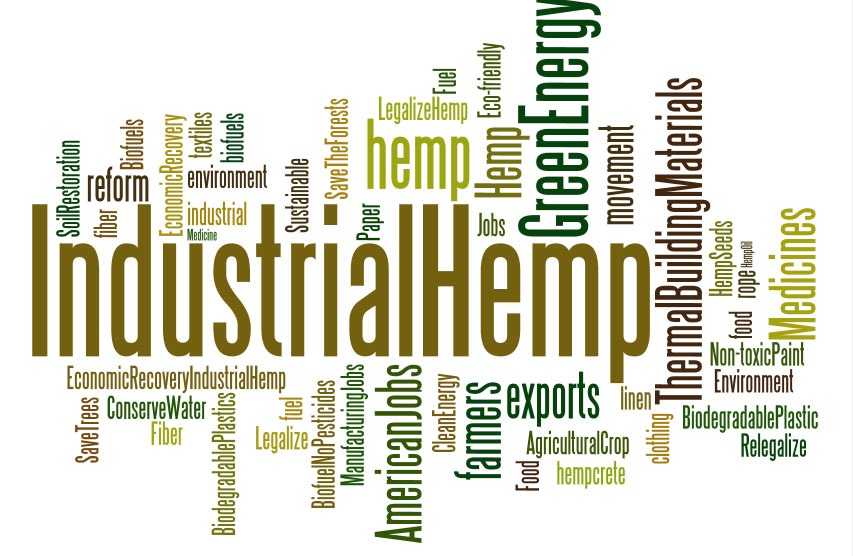
Hemp is the common name for plants of the entire genus Cannabis. This term is often used to refer only to Cannabis strains cultivated for industrial (non-drug) use.
Industrial hemp has many uses, including paper, textiles, biodegradable plastics, construction, health food, and fuel. It is one of the fastest growing biomasses knownand one of the earliest domesticated plants known. It also runs parallel with the "Green Future" objectives that are becoming increasingly popular. Hemp requires little to no pesticides no herbicidescontrols erosion of the topsoil, and produces oxygen. Furthermore, hemp can be used to replace many potentially harmful products, such as tree paper (the processing of which uses chlorine bleach, which results in the waste product polychlorinated dibensodioxins, popularly known as dioxins, which are carcinogenic, and contribute to deforestation, cosmetics, and plastics, most of which are petroleum-based and do not decompose easily. The strongest chemical needed to whiten the already light hemp paper is non-toxic hydrogen peroxide.
Cannabis sativa L. subsp. sativa var. sativa is the variety grown for industrial use in Europe, Canada, and elsewhere, while C. sativa subsp. indica generally has poor fiber quality and is primarily used for production of recreational and medicinal drugs. The major difference between the two types of plants is the appearance and the amount of THC secreted in a resinous mixture by epidermal hairs called glandular trichomes. Strains of Cannabis approved for industrial hemp production produce only minute amounts of this psychoactive drug, not enough for any physical or psychological effects. Typically, Hemp contains below 0.3% THC, while Cannabis grown for marijuana can contain anywhere from 6 or 7 % to 20% or even more.
Industrial Hemp is produced in many countries around the world. Major producers include Canada, France, and China. While more hemp is exported to the United States than to any other country, the United States Government does not consistently distinguish between marijuana and the non-psychoactive Cannabis used for industrial and commercial purposes.
Farming Hemp
It's possible to grow hemp organically on most of the world's farmland. There are many varieties that can be selected for their various characteristics - high oil content or fibres of particular lengths - with seed banks holding over 100 strains of industrial hemp.
With a long tap root able to reach water, bind and aerate the soil where other plants can't, hemp crops can be used to reclaim land in areas prone to drought ( e.g. African Sahara) or flooding.
Once harvested the crop has a high yield of cellulose, edible proteins, oils and fibres with over 50,000 different product applications across a whole array of industries.
A long and very strong 'bast' fibre, hemp fibre has been used for thousands of years to manufacture clothing, twines, ropes and cordage, and is an excellent complement to fibres such as flax, silk, nettle and cotton in fabric blends. It can be used to produce many weights and blends of fabrics for applications, from the heaviest sofa cover to the finest ball-gown. Hemp fabric also has natural anti-mildew, UV protection and thermodynamic and hypoallergenic properties, making it desirable for use in many products. The fibre also has applications for 'fibreglass' and in paper-making.
A crop for the future? With modern farming in big trouble, farmers are being paid not to cultivate their land, and food mountains are burnt in developed countries, while billions of people go hungry in developing countries. Hemp represents a lifeline crop for rural and hunger-prone areas, of particular value for its' versatility and organic nature. A famine-stricken village could clothe, house and feed themselves from one hemp field!
In the developed world, we still rely on machinery from the turn of the century to harvest and process emerging hemp crops. Gradually, new processing machinery is being designed and implemented, and present machinery converted so that the new hemp crops are just as easy to process as cotton and hay.
Up to 90% of the worlds' paper manufactured before 1883 was made from cannabis hemp, and some historically important documents were written on hemp including the Gutenberg Bible and the first two drafts of the US Declaration of independence.
Deforestation is considered by many to be one of the most serious and dangerous practices in the world today. We are destroying the very source of our oxygen and bio-diversity to pump out, amongst other things, daily newspapers that continue to lie to the public about many things, from world wars, to the benefits of using hemp as a sustainable crop.
Hemp produces 4 times the raw material than trees for paper making. Hemp can be planted between 1-3 times a season, depending on location and can be recycled up to 10 times, compared to 3 or 4 for wood pulp paper. The same fibre products that the hemp harvest produces also provides raw-materials for a host of other sustainable products.
If today is a typical day on planet Earth, we will lose 116 square miles of rainforest, or about an acre a second. We will lose another 72 square miles to encroaching deserts, as a result of human mismanagement and overpopulation. We will lose 40 to 100 species, and no one knows whether the number is 40 or 100. Today the human population will increase by 250,000. And today we will add 2,700 tons of chlorofluorocarbons to the atmosphere and 15 million tons of carbon. Tonight the Earth will be a little hotter, it's waters more acidic, and the fabric of life more threadbare.






